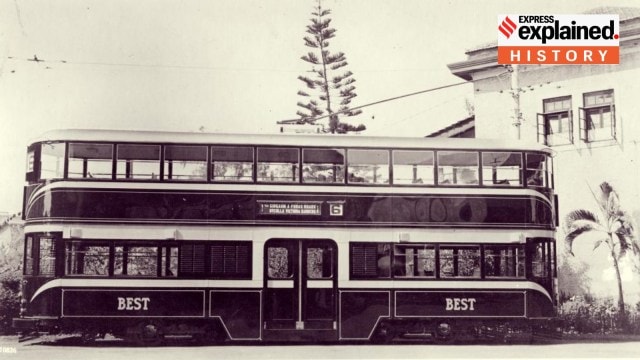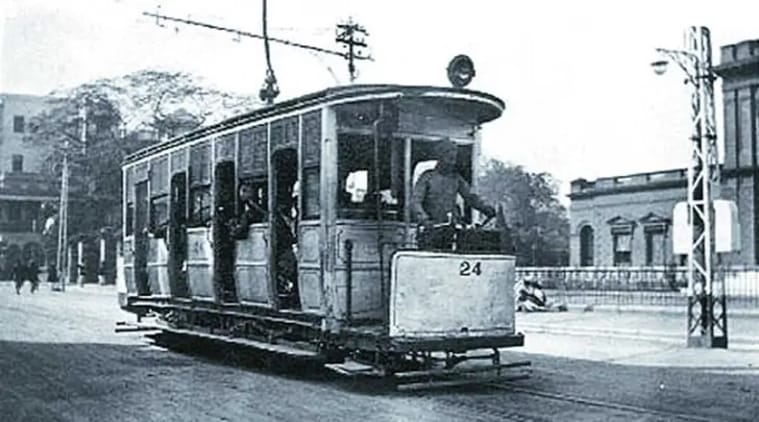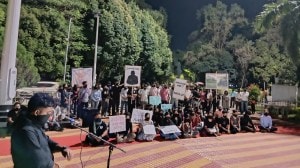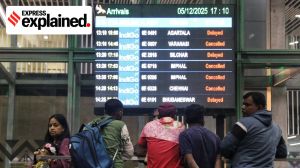Once upon a tram: The story of India’s tramways
Bombay’s very first horse-drawn trams began operations 150 years ago. Here is the story of trams in India, from their rise revolutionising urban transport to their eventual demise post-Independence.
 A double-decker tram in Mumbai, operated by BEST. Today, BEST operates Mumbai's bus service. (X/@mumbaiheritage)
A double-decker tram in Mumbai, operated by BEST. Today, BEST operates Mumbai's bus service. (X/@mumbaiheritage)Bombay’s very first horse-pulled trams began operations 150 years ago, on May 9, 1874.
These trams, pulled by between two and six horses, plyed on two routes — Colaba to Pydhonie via Crawford Market, and Bori Bunder to Pydhonie. A ticket cost one anna (16 annas make a rupee), and the tram carriages travelled at a leisurely 8 kmph pace, about that of a not-so-brisk jog.
Trams have long disappeared from the streets of Mumbai. In fact, Kolkata remains the only city in India where they are still operational. Once upon a time, however, they could be found across India, from metropolises like Delhi, Bombay and Madras, to smaller towns such as Patna and Bhavnagar. Here is a brief history.
BEST Transport Service completes 150 years ( Started on 9th May 1874 ) #Sesquicentennial #Anniversary . #Mumbai #lifeline #best . Exhibition showcasing BEST Tram Era till date at BEST Museum,Anik Depot from 9th to 11th May 2024 between 10.00 to 17.00 hrs. pic.twitter.com/IF3rsC5X9L
— BEST Bus Transport (@myBESTBus) May 8, 2024
At first, there were horse-powered trams
The license for horse-drawn trams was granted in Bombay in 1865, amidst the rapid expansion of the Presidency city. The project, however, fell through. Rather, it was Calcutta, the then British capital, which saw India’s first tramcars enter service in 1873. Calcutta’s horse-drawn trams plied on a 3.8 km route between Sealdah and Armenian Ghat Street for less than a year, after which the service was discontinued for not being economically viable.
Bombay got its first horse-drawn trams in 1874, followed by Patna in 1886 where tracks stretched from Patna City (Old Patna) and Bankipore, 3 km away. In 1889, an 8 km long tramline was inaugurated in Nasik, stretching from the present day Old Municipal Corporation building located on the Main Road, to the Nashik Road railway station.
These initial tram systems were little more than horse taxis being driven on fixed lines. They were slow and required an immense number of horses to operate, which created an issue with regards to economic viability.
Steam locomotives found limited adoption
Trams re-emerged in Calcutta in 1880, with Lord Ripon inaugurating a new, longer, metre-gauge route between Sealdah and Armenian Ghat Street via Bowbazar Street, Dalhousie Square and Strand Road. Two years later, the Calcutta Tramway Company began experimenting with steam locomotives to pull trams.
But older locomotives were notoriously unreliable, and extremely polluting, drawing opposition from citizens, an impediment to their universal adoption. By the end of the 19th century, the Calcutta Tramway Company boasted of seven locomotives, and over 1000 horses. Mumbai, Nasik or Patna never switched to steam locomotives at all.
However, steam locomotives did see success in some cases. In 1907, the Cochin State Forest Tramway began operations, transporting teak and rosewood from the forests of Palakkad to the town of Chalakudy in Thrissur District — a nearly 80 km long route. In 1926, under the reign of Colonel Maharaja Raol Sir Shri Krishna Kumarsinhji Bhavsinhji, locomotive-driven tramways were introduced in the Princely State of Bhavnagar.
Electric trams revolutionised urban transport
In 1895, Madras saw India’s first electric tramways enter service, with seven cars connecting the city’s docks to inland areas. Electric trams were revolutionary in that they did away with the drawbacks of both horse-drawn and steam-powered tramways. They were cleaner and less noisy, while also not necessitating the maintenance of hundreds and thousands of horses.
By 1902, Calcutta saw its first electric tramcars plying between Esplanade and Kidderpore, and Esplanade and Kalighat. Bombay would see electrification too, in 1907, under the newly formed Bombay Electric Supply and Tramway Company (BEST).
 A tram running in Old Delhi. (Express Archive)
A tram running in Old Delhi. (Express Archive)
Cawnpore too saw a 6.4-km track between the railway station and Sirsiya Ghat, which became operational in 1907. And Delhi saw its first trams a year later, in the area now known as Old Delhi. In their heyday, trams could be seen in Jama Masjid, Chandni Chowk, Chawri Bazaar, Katra Badiyan, Lal Kuan, and Fatehpuri as well as Sabzi Mandi, Sadar Bazar, Paharganj, Ajmeri Gate, Bara Hindu Rao and Tis Hazari.
A sad, sudden demise
By the 1960s, tramways, which were once seen as a revolutionary development in urban transport, had all but vanished in India. Even Kolkata’s last remaining trams are perpetually under the threat of being discontinued.
This happened due to a number of reasons. Patna was the first city to discontinue its tram service in 1903, on account of low ridership. Nasik shut down its tramways in 1933, in the aftermath of successive years of famine and plague. Cawnpore shut its trams down in the same year after running into insurmountable losses. Madras’s tram company would go bankrupt in 1950, and operated its last tram in 1953.
Moreover, ‘better’ alternatives soon took over urban transport. In Bombay, as the suburban railways extensively connected the city to its suburbs, and buses took to the streets, trams quickly became obsolete. After all, they were slower and had much limited reach than either of the two alternatives. Bombay saw its last trams operating in 1964, a year after they were discontinued in Delhi on account of urban congestion.
This is an edited version of an explainer first published on February 24, 2023.
- 01
- 02
- 03
- 04
- 05






































